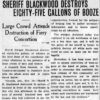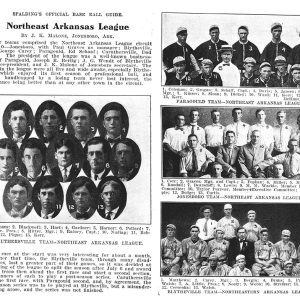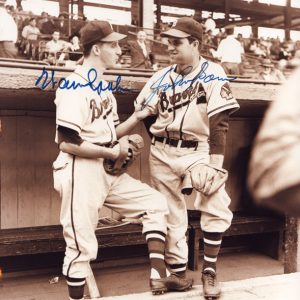calsfoundation@cals.org
Northeast Arkansas League
The Class D Northeast Arkansas League was established in July 1909 after the Arkansas State League folded. Two of its franchises, Newport (Jackson County) and Jonesboro (Craighead County), joined baseball clubs from Marianna (Lee County) and Paragould (Greene County) to form the league. It was sanctioned by the National Association of Professional Baseball Leagues (NAPBL), the administrative agency of minor league baseball from 1901 to the present.
After a successful inaugural season, violence and fiscal woes marred the 1910 and 1911 seasons. At the conclusion of the 1910 season, the Caruthersville, Missouri, and Paragould franchises were separated by only a half game in the standings. The league championship rested on the outcome of a five-game series between the two teams. Tied at two games apiece, the series was canceled after a “riot” erupted during the series finale. In 1911, struggling financially, the fledgling league folded on July 5.
In 1936, the Northeast Arkansas League was re-established. Early in February 1936, the NAPBL’s promotional director of the Southern Division, J. Walter Morris, met with a group of businessmen from Jonesboro who were interested in establishing a league. Morris commissioned a “survey of the region” in order to determine the viability of the league. The results of the survey proved to be favorable. Subsequently, the league’s organizers appointed Joseph R. Bertig of Paragould to be the league’s president. Bertig served as the league’s president for all six seasons of its existence. Then, a public announcement heralded the return of the Class D Northeast Arkansas League.
At the time, the NAPBL’s classification structure ranged from Class A to D. Class D was the lowest level of competition in professional baseball. By April, clubs from Jonesboro, Paragould, Newport, Osceola (Mississippi County), Batesville (Independence County), and West Plains, Missouri, were established. Then the task of securing “working agreements” commenced.
From 1936 to 1941, the league’s financial success and its stable core of franchises demonstrated the region’s affection and support for baseball. This edition of the Northeast Arkansas League also reflected a level of business acumen in professional baseball that was lacking in 1909. Working agreements with a major league club provided a franchise with players who were property of, and were paid by, a major league franchise. On occasion, agreements with a higher classification minor league franchise were negotiated in order to obtain players on loan. The league’s franchises were generally successful in securing working agreements, which played a crucial role in maintaining a stable core of franchises and a steady supply of talented players, as well as infusing cash into local economies.
One business leader in Newport viewed their franchise as “equivalent to the location of a small factory.” Furthermore, springtime also meant the arrival of minor league baseball camps for some Northeast Arkansas League towns. For instance, every April from 1939 to 1941, the St. Louis Browns held a minor league spring training camp in Paragould, annually filling the town’s finest hotel. Fans across the league enjoyed a consistently high caliber of play.
The league’s mid-season all-star games were particularly popular with the league’s fans. In 1938, the league broke new ground in organized professional baseball by holding two all-star games in one season. On July 7, 1938, 1,500, fans packed Legion Park in Jonesboro to see the season’s all-star game. The Paragould club hosted a second all-star game on August 12. Promotional events and contests also attracted fans to the ballpark.
In 1938, the renowned barnstorming team the Israelite House of David drew a large crowd when it played an exhibition game against the Batesville White Sox. Perhaps the most popular promotional event occurred in Jonesboro in 1941. The Jonesboro Giants held a season-long contest to elect the “Queen of the Diamond.” At the end of the season, more than 100,000 ballots were cast for a dozen contestants. In addition to promotions and events, the league provided its fans with a first look at several future major league players.
Three Arkansans who played in the league went on to enjoy successful major league careers: Johnny Sain, Marlin Stuart, and National Baseball Hall of Fame inductee George Kell. Other notable league alumni included Hank Arft, Whitey Kurowski, Clarence Iott, Boris Martin, and Pete Reiser.
Although successful at the conclusion of the 1941 season, the league was unable to operate during World War II. Demographic shifts and the changing business of baseball spelled the end of minor league baseball in northeast Arkansas.
|
Teams and Nicknames
|
Years of Participation
|
| Batesville White Sox/Pilots | 1936, 1938, 1940–1941 |
| Blytheville Boosters/Giants
League Champions 1937 and 1938 |
1910–1911, 1937–1938 |
| Caruthersville Alfalfas/Pilots
League Champions 1936 and 1939 |
1910, 1936–1940 |
| Helena Hustlers | 1911 |
| Jonesboro Zebras/Giants/White Sox
League Champions 1909 |
1909–1911, 1936–1941 |
| Marianna Brickeys | 1909 |
| Newport Pearl Diggers/Cardinals/
Tigers/Dodgers League Champions 1941 |
1909, 1936–1941 |
| Osceola Indians | 1936–1937 |
| Paragould Scouts/Rebels/Browns
League Champions 1940 |
1909–1911, 1936–1941 |
| West Plains Badgers
Relocated to Caruthersville June 1936 |
1936 |
For additional information:
Edwards, Paul. “Farmers and Fastballs: The Culture of Baseball in Depression Era Northeast Arkansas.” Arkansas Review: A Journal of Delta Studies 41 (August 2010): 109–122.
Johnson, Lloyd, and Miles Wolff, eds. Encyclopedia of Minor League Baseball. 3rd ed. Durham, NC: Baseball America, 2007.
“Newport Prepares For Big Baseball Year.” Newport Daily Independent. April 23, 1936, p. 2.
“Queen of the Diamond Crowned.” Jonesboro Evening Sun. September 2, 1941, p 1.
Voight, David Quentin. Baseball: An Illustrated History. University Park: Pennsylvania State University Press, 1987.
Paul Edwards
Boston, Massachusetts
 Blackwood, Dwight Hale
Blackwood, Dwight Hale Recreation and Sports
Recreation and Sports George Kell
George Kell  Northeast Arkansas League Teams
Northeast Arkansas League Teams  Paragould Browns
Paragould Browns  Johnny Sain
Johnny Sain 




Comments
No comments on this entry yet.